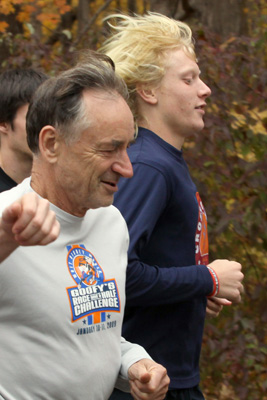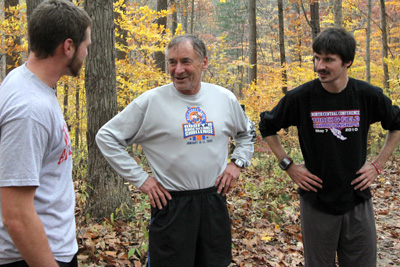
Steve Charles—Bernd Heinrich said he doesn’t do this very often—visit a small college, join a class for an hour-long discussion about one of his books, then give a talk that evening about his life. (See a photo album here.)
Asked what drew him to Wabash and Professor Greg Redding’s freshman tutorial, the naturalist, world class ultra-marathoner, award-winning writer and best-selling author said: “It was the running.”
The students in Greg’s tutorial, The Theory and Lore of Running, had read Heinrich’s Why We Run: A Natural History, a retitled release of his book originally titled Racing the Antelope. Heinrich said he prefers that original title. And the students sure loved that image. One of the arguments of the book is that humans evolved to be ultra-distance runners that could run down even the swiftest prey, through a combination of endurance, intelligence, and the desire to win.
Greg is a professor of German and former cross-country runner turned ultra-marathoner. When he created the tutorial he envisioned introducing freshmen to a passion of his own and, through that passion and the close reading of texts and discussion, initiating these new Wabash students into the art of asking questions about things that matter to you. Then most of the freshmen on the College’s NCAC Conference Champion cross country team signed up. So rather than presenting his avocation to most of the class, Greg’s leading a group in which more than half share that passion.
Heinrich is a German-born American professor emeritus of biology at the University of Vermont, a writer, and runner who, now in his seventies, still holds records in the ultra-marathon. He was a perfect fit for this class. Much of the early back and forth during his visit with the class in the Detchon Reading Room focused on specific statements about evolutionary biology or moments about Heinrich’s own running exploits as detailed in the book. One student asked if Heinrich thought we could evolve to run even faster.
But the question that got the students sitting up and leaning forward to listen came from Sean Lewis ’15: “Do you think we’ll ever be able to chase down a pronghorn antelope?” Heinrich talked about a magazine article describing just such an attempt.
Then he had a scoop for the class. A tv producer had told Heinrich about a documentary inspired by Why We Run that he was shooting out west and in which they hoped to film human runners racing this animal (which can run at a sustained speed of 30 mph with bursts up to 60 mph) and eventually chasing it down. The producer had contacted him recently to say that “something dramatic” had happened during the filming, but he didn’t say what and didn’t want to give away the ending of the show. Heinrich takes that to mean they may have succeeded, but he didn’t know.
But the highlight of the day may have come when several of the students were able to join Redding and Heinrich after lunch for a run through nearby Shades State Park, where Redding trains for his own ultramarathons. Redding had planned a short run, but every time they’d stop to talk for a while, the group wanted to keep going.

Heinrich, who splits his time between Vermont and a cabin in the Maine woods, was in his element. His best-selling books include Winter World and Summer World, of which writer Bill McKibben has said, “It is possible there is a better guide to the world around us than Bernd Heinrich, but I’ve not come across him.” He was asking questions of the students and Redding about the trees, birds, the terrain over which they were running. He talked about the ways his running had informed his scientific research (one published paper had been based on the flowers that grew along his daily running course!) and his writing (the running freed him up mentally, allowed him to think in ways he otherwise would not have considered). Students shared their own stories. Heinrich and one of the students were picking up nuts from the forest floor and cleaning them. The conversations were more relaxed than in class, but the learning in that setting—inspired by running and walking together—may be even more long-lasting. Cross country Coach Roger Busch told me that several from the class had posted comments about the day on their Facebook pages; those who had run with Heinrich were the most enthusiastic.
After his moving talk on Thursday night, I asked Professor Heinrich if he’d enjoyed his time at Wabash. “Very much,” he said. I said that I thought the students had gained much from his time with them, especially those who had accompanied him on the trails at Shades. Just two months into their Wabash careers and here they were, running and exploring the outdoors with a world class ultramarathoner and a world-renowned naturalist.
“I was just another runner,” Heinrich said. And that, of course, is the power of such moments.